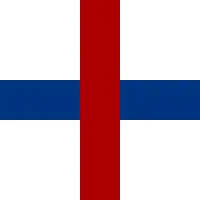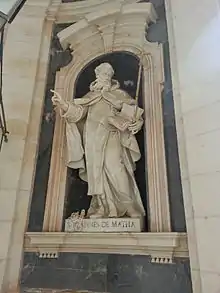John of Matha
Saint John of Matha (1160–1213) was a Christian saint of the 12th century and founder of the Order of the Most Holy Trinity, dedicated to ransoming captive Christians.
Saint John of Matha | |
|---|---|
 | |
| Confessor; Founder of the Trinitarians | |
| Born | June 23, 1160 Faucon-de-Barcelonnette |
| Died | December 17, 1213 Rome |
| Venerated in | Catholic Church |
| Canonized | Cultus confirmed 21 October 1666 by Pope Alexander VII |
| Feast | December 17[1] (Ordinary Form); February 8 (Extraordinary Form) |
| Attributes | purse, man in Trinitarian habit, with the white with blue and red cross on the breast, with chains in his hands or at his feet, captives near him, and his mitre at his feet |
Background
Between the eighth and the fifteenth centuries medieval Europe was in a state of intermittent warfare between the Christian kingdoms of southern Europe and the Muslim polities of North Africa, Southern France, Sicily and portions of Spain. According to James W. Brodman, the threat of capture or kidnapping, whether by Muslim pirates or coastal raiders, or during one of the region's intermittent wars, was a continual concern for residents of Catalonia, Languedoc, and other coastal provinces of medieval Christian Europe.[2] Raids by Muslim bands and armies was an almost annual occurrence.[3]
The redemption of captives is listed among the corporal works of mercy. The period of the Crusades, when so many Christians were in danger of falling into the hands of Muslims, witnessed the rise of religious orders vowed exclusively to this pious work.[4]
Life and Work
Most of the story of John of Matha's life is based on legends that circulated after his death. It is reasonably certain that he was born to noble parents Euphemius and Martha at Faucon-de-Barcelonnette, on the borders of Provence on June 23, 1169. He was baptised John, in honour of St. John the Baptist. His father Euphemius sent him to Aix-en-Provence, where he learned grammar, fencing, riding, and other exercises fit for a young nobleman. It is said that while there he gave the poor a considerable part of the money his parents sent him, and he visited the hospital every Friday, assisting the sick poor.[5]
He studied theology at the University of Paris and was ordained a priest at the age of 32 in December 1192.[6] According to Trinitarian tradition, on January 28, 1193, John celebrated his first Mass. During that Mass, he was struck with a vision of Christ holding by the hand two chained captives, one a Moor, the other a Christian (the Crusades were in full force at the time). The Christian captive carried a staff with a red and blue cross. After the Mass, John decided to devote himself to the task of ransoming Christian captives from the Moors.[6] Before entering upon this work, he thought it needful to spend some time in retirement, prayer, and mortification; and having heard of a holy hermit, St. Felix of Valois, living in a great wood near Gandelu, in the diocese of Meux, he repaired to him and requested him to instruct him in the practice of perfection.[5]
Order of the Most Holy Trinity
One day while walking with Felix, John had another vision—a white stag appeared at a stream with a red and blue cross between its antlers.[6] John disclosed to Felix the design he had conceived on the day on which he said his first mass, to succour captive Christians under slavery, and Felix offered his help in carrying it out. They set out for Rome in the midst of a severe winter, towards the end of the year 1197, to obtain the pope's benediction.[5]

On December 17, 1198, he obtained the preliminary approval of Pope Innocent III for a new order dedicated in honour of the Blessed Trinity for the redemption of Christian captives. This order was fully approved in 1209. The Order of the Most Holy Trinity's first monastery was established at Cerfroid (just north of Paris) and the second at Rome at the church of San Tommaso in Formis. Christian slaves were first rescued by the Order in 1201. In 1202 and 1210 John travelled to Tunisia himself and brought back countless Christian slaves.
Before his death, Trinitarian tradition says he met St. Francis of Assisi and introduced Francis to the Frangipani family, one of the benefactors of the Franciscan order. St. John of Matha died on December 17, 1213, in Rome in the house of St. Thomas In Formis on the Caelian Hill.[1]
Our Lady of Good Remedy
St. John founded the Trinitarians to go to the slave markets, buy the Christian slaves and set them free in the name of the Holy Trinity. To carry out this plan, the Trinitarians needed large amounts of money. So, they placed their fund-raising efforts under the patronage of Mary, the Mother of God. In gratitude for her assistance, St. John of Matha honored Mary with the title of "Our Lady of Good Remedy." Devotion to Mary under this ancient title is widely known in Europe and Latin America, and the Church celebrates her feast day on October 8. Our Lady of Good Remedy is often depicted as the Virgin Mary handing a bag of money to St. John of Matha.[7]
Veneration

In 1655, his relics were transferred from Rome to Madrid. His cultus was approved in 1665 and his feast day is December 17.
Legacy
The Order of the Most Holy Trinity is active on five continents and in many countries.[1]
DeMatha Catholic High School located in Hyattsville, Maryland, US is named after him. It is also sponsored by the Trinitarians.
Saint-Jean-de-Matha is a village in the province of Quebec.
In 1865 American poet John Greenleaf Whittier composed an anti-slavery poem entitled "The Mantle of St. John De Matha".
References
- "About the Trinitarians' Saints and Blesseds"
- Brodman, James William, Ransoming Captives in Crusader Spain:The Order of Merced on the Christian-Islamic Frontier, 1986
- Ibn Khaldun, Histoire des Berbères et des dynasties musulmanes de l'Afrique septentrionale, ed. Paul Casanova and Henri Pérès, trans. William MacGuckin, baron de Slane (Paris, 1925-56), 3: 116-17
- Moeller, Charles. "Order of Trinitarians." The Catholic Encyclopedia. Vol. 15. New York: Robert Appleton Company, 1912. 22 Feb. 2013
- Butler, Rev. Alban, Taken from Vol. I of "The Lives or the Fathers, Martyrs and Other Principal Saints", Vol. I, D. & J. Sadlier & Co., 1864
- ""History of John de Matha", DeMatha Catholic High School, Hyattsville, MD". Archived from the original on 2013-01-26. Retrieved 2013-02-22.
- Our Lady of Good Remedy
Sources
- Holweck, F. G., A Biographical Dictionary of the Saints. 1924.